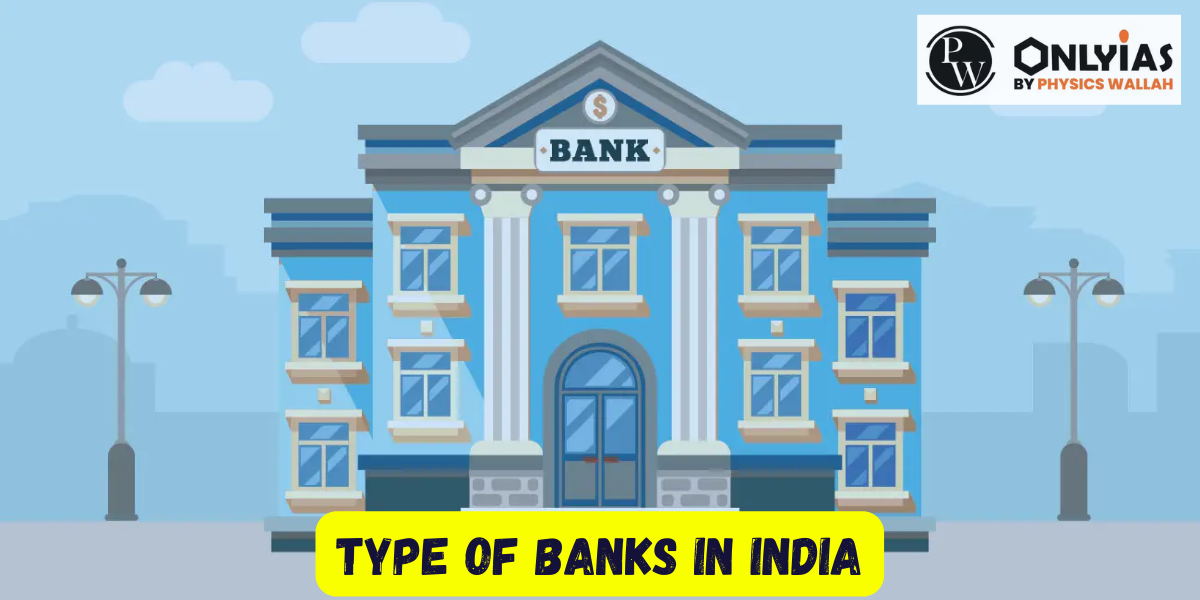![]() Madhavi Gaur
Madhavi Gaur
![]() August 08, 2023 12:00
August 08, 2023 12:00
![]() 5597
5597
![]() 0
0
Type of Banks in India: India's banking sector is a crucial component of the country's financial system, providing a wide range of services to individuals, businesses, and the government.

Type of Banks in India: India’s banking sector is a crucial component of the country’s financial system, providing a wide range of services to individuals, businesses, and the government. Over the years, the banking landscape in India has evolved, giving rise to various types of banks catering to different needs and segments of the economy. In this article, we will explore the different types of banks operating in India and the unique roles they play.

Bank functions are relatively consistent, although the specific clientele and sectors they serve may vary. In India, banks perform the following functions:
1. Receiving deposits from the general public.
2. Offering convenient withdrawal services.
3. Extending loans to customers.
4. Facilitating fund transfers.
5. Issuing drafts for transactions.
6. Providing safe locker facilities for customers.
7. Engaging in foreign exchange transactions.
India’s banking system comprises a diverse range of institutions, each catering to specific financial needs and clienteles. From traditional public sector banks to innovative private banks and specialized entities, this guide offers a concise glimpse into the various types of banks operating in the country. Let’s explore their functions, features, and significance in India’s ever-evolving financial landscape. Whether you seek basic knowledge or insights for investment, this resource will be your go-to reference for understanding the Indian banking system.
Four types of bank in India: In the vast and dynamic banking sector of India, four distinct types of banks stand out, each contributing to the nation’s economic growth and financial stability. These banks cater to various segments of the population and offer specialized services to meet diverse financial needs. In this concise guide, we will explore the four major types of banks in India, shedding light on their roles, functions, and importance in the country’s financial landscape. Whether you’re a curious individual or a potential investor, this brief overview will provide valuable insights into the different facets of banking in India. Let’s dive into the world of Indian banks and discover what sets each type apart.
Public Sector Banks (PSBs) are financial institutions where the majority stake is owned by the government. These banks play a significant role in promoting financial inclusion and implementing various government schemes. The primary objectives of PSBs include providing banking services to all sections of society, especially to the underprivileged and economically weaker sections.
Characteristics of Public Sector Banks in India:
Private Sector Banks are financial institutions where the majority of shares are owned by private individuals, corporations, or institutional investors. These banks operate under the guidelines and regulations set by the Reserve Bank of India (RBI) but have more flexibility in terms of their business operations and strategies.
Characteristics of Private Sector Banks in India:
Foreign Banks are financial institutions that have their headquarters outside India but operate within the country through branch networks. These banks bring global expertise and specialized financial services to Indian customers, contributing to the diversification and development of the Indian banking sector.
Characteristics of Foreign Banks in India:
Regional Rural Banks (RRBs) are specialized banking institutions established to serve rural and agricultural communities. These banks were created to bridge the gap between the banking sector and rural areas, ensuring the availability of banking services in remote and underserved regions.
Characteristics of Regional Rural Banks in India:
Cooperative Banks are unique entities that operate on the cooperative principles of self-help and mutual aid. These banks are formed by a group of individuals who pool their resources to meet their common financial needs.
Characteristics of Cooperative Banks in India:
Payment Banks are a relatively new addition to the Indian banking sector, introduced by the RBI to enhance financial inclusion and digital payments. These banks focus on providing basic banking services such as deposits and remittances, but they do not lend money or issue credit cards.
Characteristics of Payment Banks in India:
The Table below depicts the comparison of Different Types of Banks in India:
|
Comparison of Different Types of Banks in India |
|||
|---|---|---|---|
| Bank Type | Ownership | Focus | Services Offered |
| Public Sector Banks | Government-owned | Financial inclusion and government schemes | Full-fledged banking services |
| Private Sector Banks | Private shareholders | Customer-centric services and innovation | Full-fledged banking services |
| Foreign Banks | Headquartered abroad | Global banking expertise and services | International and domestic banking services |
| Regional Rural Banks | Joint partnership | Rural and agricultural communities | Credit and financial services for rural areas |
| Cooperative Banks | Owned by members | Self-help and mutual aid | Banking services for members and communities |
| Payment Banks | Private shareholders | Financial inclusion and digital payments | Basic banking and digital payment services |

The table below contains the list if Major Commercial Banks in India:
|
Major Commercial Banks in India |
|||
|---|---|---|---|
| Bank Name | Type | Headquarters | Year Established |
| State Bank of India | Public Sector Bank | Mumbai, Maharashtra | 1955 |
| HDFC Bank | Private Sector Bank | Mumbai, Maharashtra | 1994 |
| ICICI Bank | Private Sector Bank | Mumbai, Maharashtra | 1994 |
| Punjab National Bank | Public Sector Bank | New Delhi, Delhi | 1894 |
| Axis Bank | Private Sector Bank | Mumbai, Maharashtra | 1993 |
| Bank of Baroda | Public Sector Bank | Vadodara, Gujarat | 1908 |
| Kotak Mahindra Bank | Private Sector Bank | Mumbai, Maharashtra | 2003 |
| Canara Bank | Public Sector Bank | Bengaluru, Karnataka | 1906 |
| IndusInd Bank | Private Sector Bank | Mumbai, Maharashtra | 1994 |
| Union Bank of India | Public Sector Bank | Mumbai, Maharashtra | 1919 |
The variety of banks in India reflects the diverse needs of the population and the efforts to cater to different segments of society. Each type of bank serves its specific purpose, contributing to the overall growth and development of India’s economy. As the financial landscape continues to evolve, these banks will play an essential role in shaping India’s financial future.
| Related Links | |
|---|---|
| Important Banking Terms | |
<div class="new-fform">
</div>

Latest Comments